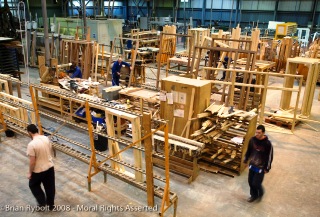The joinery sector remains optimistic about an increase sales volumes, despite slightly disappointing results from the BWF Joinery State of Trade survey Q2 2013.
BWF Policy Executive Matt Mahony commented on the findings:
 “It was perhaps surprising that a number of respondents reported a disappointing Q2 relative to the weather hit Q1. Sales volumes in the last quarter didn’t increase as much as respondents expected, in fact, on balance respondents indicated a small decrease with no significant trends noted in terms of location, product market or size of company.”
“It was perhaps surprising that a number of respondents reported a disappointing Q2 relative to the weather hit Q1. Sales volumes in the last quarter didn’t increase as much as respondents expected, in fact, on balance respondents indicated a small decrease with no significant trends noted in terms of location, product market or size of company.”
“Anecdotal evidence and industry predictions suggest that we could be looking at better fortunes for joinery manufacturers in Q3, as the housing recovery, a general uplift in construction work, and fair weather will all be likely to boost activity. But the Q2 results serve as a reminder that growth for the joinery sector continues to be slow if at all, and it shouldn’t be taken for granted in what remains an exceptionally competitive marketplace.”
Key points from the BWF Joinery State of Trade Survey Q2 2013 include:
– For the second successive quarter, a balance of 7 % of respondents noted a decrease in sales volumes. In the previous survey (Q1 2013) 37%, on balance, had predicted that sales volumes would increase in this period.
– Despite this, manufacturers again remained confident that sales volumes would improve in the next quarter, with a balance of 19% predicting an increase, and a balance of 20% predicting an increase over the next year.
– Although only 40% of respondents had used more than 70% of their manufacturing capacity for the last year, this was anticipated to increase to 69% and 74% over the next quarter and year.
– Only 7% of companies reported a current order book of future work extending beyond 3 months, with around two thirds saying that their order book extended from between 1 and 3 months.
– Demand is remains by far the most significant restriction on activity with around two-thirds listing it as a constraint.
– Raw material costs increased for 82% of respondents, with fuel and energy costs also putting inflationary pressure on unit prices.
– Investment in customer research, manufacturing equipment and e-business was set to increase over the next year, with 68% planning for a spending increase in product improvement.
Recent surveys from the construction industry and specialist sectors reported a steady upturn in fortunes and increased optimism for the second half of 2013. The latest Markit/CIPS UK Construction Purchasing Managers' Index indicating a ‘solid increase in construction employment levels and ‘the strongest degree of positive sentiment about future output since May 2010’. It showed an increase in all areas of construction in July, with housebuilding leading the way.
The Q2 results for the NSCC State of Trade Survey 2013 showed specialist contractors reporting an increase in enquires for the third quarter in a row, up to a 6-year high of 49%, with only 24% reporting a decrease.
Despite predicting growth in 2014 and 2015, the Construction Products Association urged some caution in its latest industry forecasts, noting that earlier this year the industry had seen its lowest levels since 2001 and even with growth expected in the second half of this year, output was likely to fall 1.5% for 2013.
Look out for the Q3 survey in the next few weeks.
BWF members will be able to view the full 2013 Q2 report simply by logging in to this page below.